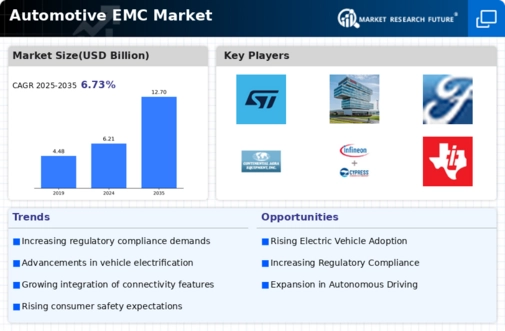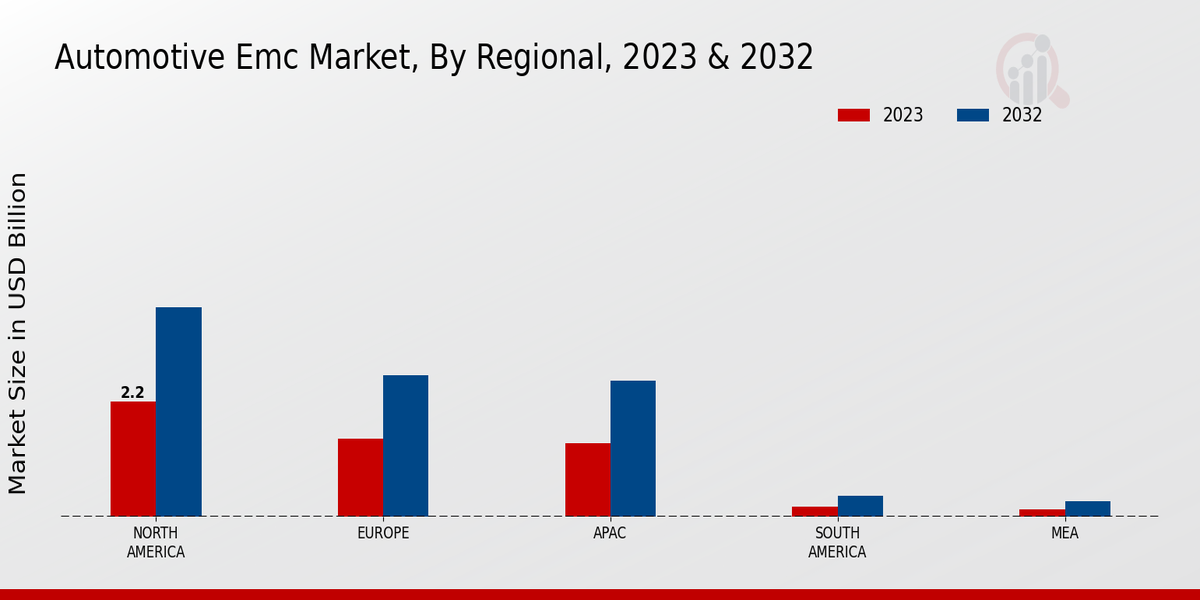Market Growth Projections
The Global Automotive EMC Market Industry is projected to experience substantial growth over the coming years. With an estimated market value of 6.21 USD Billion in 2024, it is anticipated to reach 12.7 USD Billion by 2035. This growth trajectory indicates a compound annual growth rate of 6.74% from 2025 to 2035. Such projections underscore the increasing importance of electromagnetic compatibility in the automotive sector, driven by factors such as vehicle electrification, regulatory compliance, and technological advancements.
Increasing Vehicle Electrification
The shift towards electric vehicles is a primary driver in the Global Automotive EMC Market Industry. As manufacturers increasingly adopt electric drivetrains, the demand for effective electromagnetic compatibility solutions rises. Electric vehicles, which often utilize high-voltage systems, require stringent EMC measures to ensure safety and performance. In 2024, the market is projected to reach 6.21 USD Billion, reflecting the growing emphasis on vehicle electrification. This trend is expected to continue, with the market potentially reaching 12.7 USD Billion by 2035, indicating a robust compound annual growth rate of 6.74% from 2025 to 2035.
Regulatory Compliance and Standards
Regulatory frameworks governing electromagnetic compatibility are becoming more stringent globally, thereby driving the Global Automotive EMC Market Industry. Compliance with these regulations is essential for manufacturers to ensure vehicle safety and reliability. For instance, the International Electrotechnical Commission and various national standards set forth guidelines that automotive companies must adhere to. As these regulations evolve, the need for advanced EMC testing and solutions becomes increasingly critical. This compliance not only mitigates risks but also enhances consumer trust, ultimately contributing to market growth and stability.
Growth of Autonomous Vehicle Technology
The advancement of autonomous vehicle technology is a crucial factor propelling the Global Automotive EMC Market Industry. As vehicles become more automated, the reliance on electronic systems increases, necessitating effective EMC measures to ensure these systems operate without interference. The integration of sensors, cameras, and communication devices in autonomous vehicles heightens the demand for comprehensive EMC solutions. This trend suggests that as the market for autonomous vehicles expands, so too will the need for specialized EMC testing and compliance, thereby driving overall market growth.
Rising Consumer Awareness of Vehicle Safety
Consumer awareness regarding vehicle safety and performance is on the rise, significantly influencing the Global Automotive EMC Market Industry. As consumers become more informed about the implications of electromagnetic interference on vehicle functionality, they increasingly prioritize safety features in their purchasing decisions. This heightened awareness drives manufacturers to invest in robust EMC solutions to meet consumer expectations. Consequently, companies that prioritize EMC in their design and production processes may gain a competitive edge in the market, leading to increased sales and market share.
Technological Advancements in EMC Solutions
The continuous evolution of technology plays a pivotal role in shaping the Global Automotive EMC Market Industry. Innovations in materials, design, and testing methodologies enhance the effectiveness of EMC solutions. For example, the development of advanced shielding materials and improved simulation tools allows manufacturers to better predict and mitigate electromagnetic interference. These advancements not only improve product performance but also reduce time-to-market for new vehicle models. As automotive technology progresses, the demand for sophisticated EMC solutions is likely to increase, further propelling market growth.























Leave a Comment